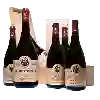
Winery Adolphe BorderieGevrey-Chambertin
This wine generally goes well with poultry, beef or veal.
Food and wine pairings with Gevrey-Chambertin
Pairings that work perfectly with Gevrey-Chambertin
Original food and wine pairings with Gevrey-Chambertin
The Gevrey-Chambertin of Winery Adolphe Borderie matches generally quite well with dishes of beef, veal or game (deer, venison) such as recipes of quick meatloaf, lamb confit with new potatoes or adapted vietnamese fondue.
Details and technical informations about Winery Adolphe Borderie's Gevrey-Chambertin.
Discover the grape variety: Othello
Interspecific cross between the Clinton and the frankenthal or black-hamburg obtained in 1859 by Charles Arnold of Paris in Canada (Brant County in Ontario). In France, it is one of the six hybrids prohibited since 1935 (included in the European regulations): the Clinton, the Herbemont, the Isabelle, the Jacquez, the Noah and the Othello. It has been used as a sire in several crosses, notably by Couderc and Seibel. Today, the Othello has practically disappeared.
Informations about the Winery Adolphe Borderie
The Winery Adolphe Borderie is one of of the world's greatest estates. It offers 6 wines for sale in the of Gevrey-Chambertin to come and discover on site or to buy online.
The wine region of Gevrey-Chambertin
The wine region of Gevrey-Chambertin is located in the region of Côte de Nuits of Burgundy of France. Wineries and vineyards like the Domaine René Bouvier or the Domaine Armand Rousseau produce mainly wines red. The most planted grape varieties in the region of Gevrey-Chambertin are Pinot noir et Gamay noir, they are then used in wines in blends or as a single variety. On the nose of Gevrey-Chambertin often reveals types of flavors of iron, coffee or lemon and sometimes also flavors of cola, jam or citrus.
The wine region of Burgundy
Bourgogne is the catch-all regional appellation title of the Burgundy wine region in eastern France ("Bourgogne" is the French name for Burgundy). Burgundy has a Complex and comprehensive appellation system; counting Premier Cru and Grand Cru titles, the region has over 700 appellation titles for its wines. Thus, Burgundy wines often come from one Vineyard (or several separate vineyards) without an appellation title specific to the region, Village or even vineyard. A standard Burgundy wine may be made from grapes grown in one or more of Burgundy's 300 communes.
The word of the wine: Concentrate
Said of a wine that is rich in all its components (sugars in sweet wines, tannins in red wines, aromatic compounds) and that leaves an impression of density, intensity and depth.














